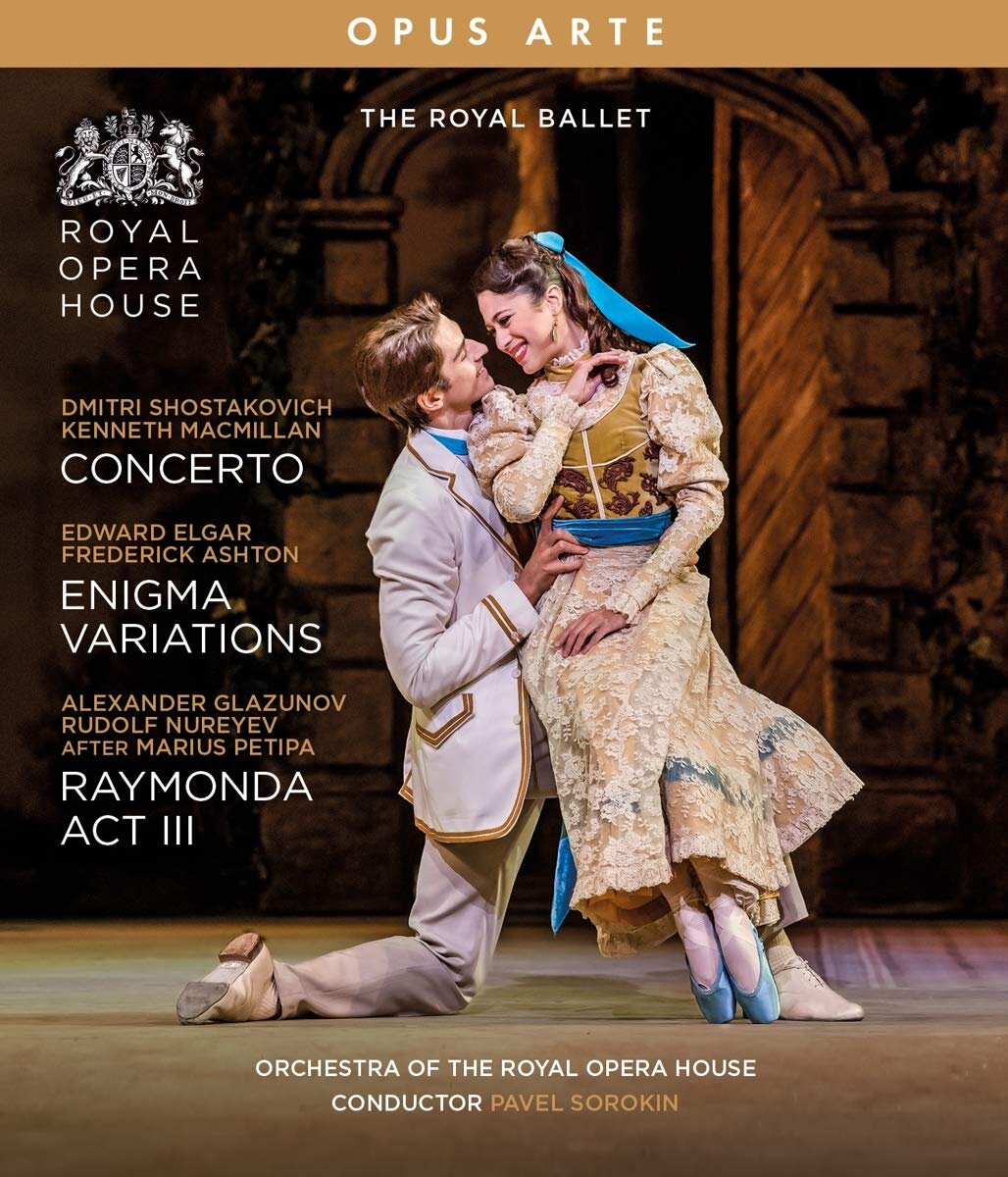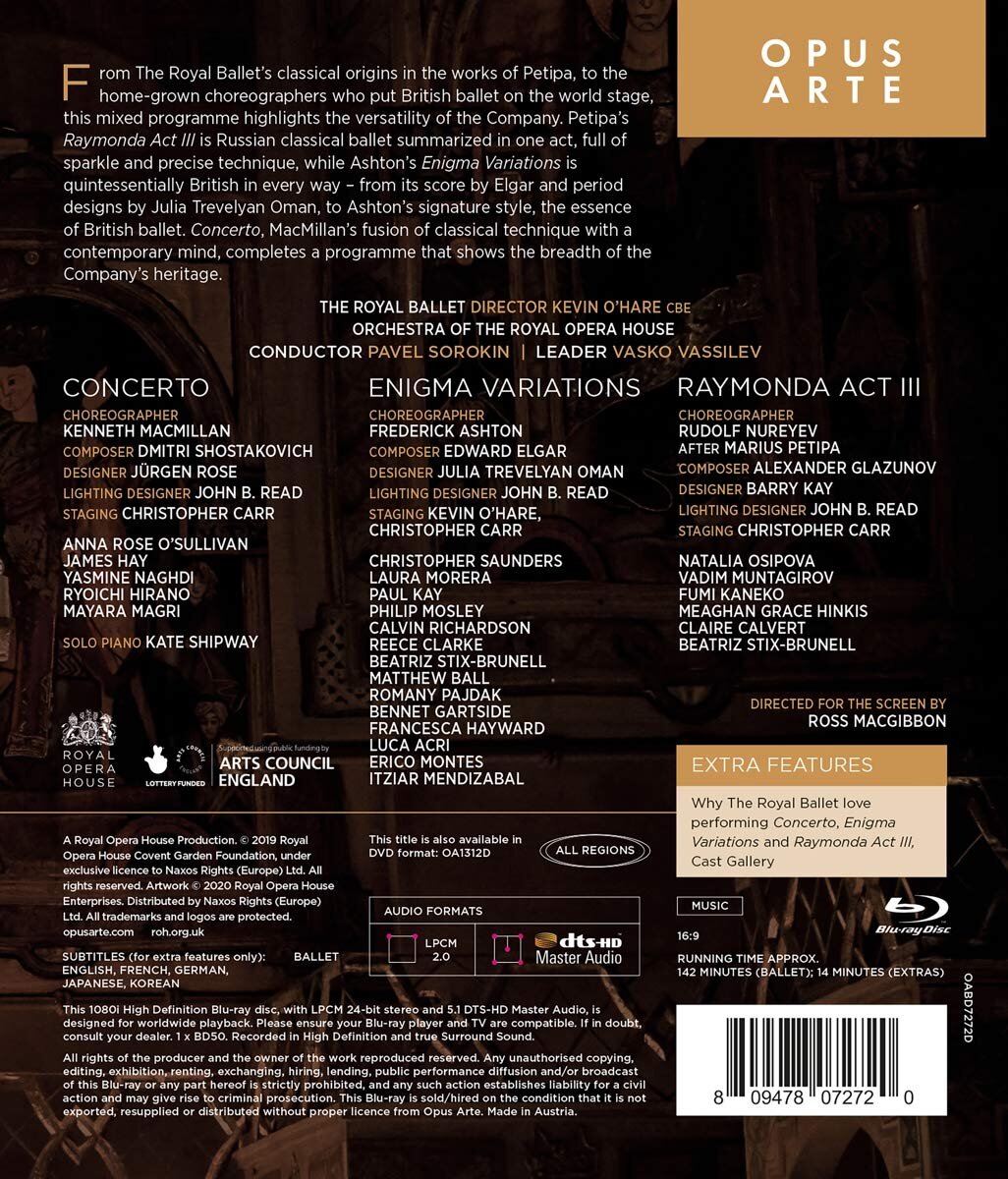

ROB Classic Program. Performed 2019 as a triple-bill at the Royal Opera House. Pavel Sorokin conducts the Orchestra of the Royal Opera House (Concert Master Vasko Vassilev):
Concerto. Choreography by Kenneth MacMillan. Music by Dmitri Shostakovich. Staged by Christopher Carr. Stars Anna Rose O’Sullivan, James Hay, Yasmine Naghdi, Ryoichi Hirano, and Mayara Magri. Also features Kate Shipway (piano). Designs by Jürgen Rose; lighting design by John B. Read.
Enigma Variations. Choreography by Frederick Ashton. Music by Edward Elgar. Staged by Kevin O’Hare and Christopher Carr. Stars Christopher Saunders, Laura Morera, Paul Kay, Philip Mosley, Calvin Richardson, Reece Clarke, Beatriz Stix-Brunell, Matthew Ball, Romany Pajdak, Bennet Gartside, Francesca Hayward, Luca Acri, Erico Montes, and Itziar Mendizabal. Designs by Julia Trevelyan Oman; lighting design by John B. Read.
Raymonda, Act III. Choreography by Rudolf Nureyev after Marius Petipa. Music by Alexander Glazunov. Staged by Christopher Carr. Stars Natalia Osipova, Vadim Muntagirov, Fumi Kaneko, Meaghan Grace Hinkis, Claire Calvert, and Beatriz Stix-Brunell. Designs by Barry Kay; lighting design by John B. Read.
Directed for TV by Ross MacGibbon. Released 2020, disc has 5.1 dts-HD Master Audio sound. Grade: D
Concerto
MacMillan made his Concerto in 1966 to Shostakovitch Piano Concerto No. 2, played here by Kate Shipway. The 1st movement is very simple and precise—you may have to watch it several times as it grows on you. Below Anna Rose O’Sulivan solos with support from a battery of sisters:
Concerto may be the best work we have ever seen from Ross MacGibbon. I did a Ballet Wonk Worksheet for all three movements. The pace is 15 seconds per video clip, and 86% of the clips show the whole bodies of the dancers. I think MacGibbon is trying to improve his video content generally—here he is helped by the fact that Concerto is abstract dancing with no plot to narrate. But, alas, we now see a new problem with the most recent ballet titles from Opus Arte: motion blur like we haven’t seen since the dawn of HDVD recordings. For example, next below see James Hay enter in a ghostly double image (sorry James):
And in the next shot below, we see both ghosting and a lack of precision in the dancing itself:
The 2nd movement is slow, which reduces the blurring problem. Next below are 3 gorgeous images of Yasmine Naghdi and Ryoichi Hirano in various poses of torrid sensuality. But when they leave the stage—more ghosts:
The next shot below shows the corps entering for the 3rd movement of Concerto. This is really bad. Opus Arte published the first fine-art HDVD ever—the Paris Opera Ballet Swan Lake in 2008. It first came out in HD DVD form and had motion sickness aplenty, but not as bad as what we see below. Later Opus Arte republished this Swan Lake in Blu-ray form, and they did a good job of cleaning up the motion artifacts on their second try. Since then we have seen a gradual reduction in motion artifacts generally. Perhaps the most stable Blu-ray images we have ever seen come to us in the recently-published Zürich Opera Ballet Romeo and Juliet from Accentus. So the state-of-the-art keeps improving. But what we see below is, I think, an unacceptable product defect. Thanks to Wonk Zachery Farr for being the first to bring all this to my attention after he watched the new Opus Arte Bayadère (Nuñez), which is also seasick:
Here’s the pose at the end of Concerto. Resolution and PQ are fine as long as the dancers don’t move!
Enigma Variations
I’ve had many phases in my life as an art fan: one for Beethoven, then Mozart, Chopin, Marc-André Hamelin (piano), Herman Hesse, The Blue Riders, Tamara Rojo, Laura Morera, etc. I never had an Elgar phase. I knew the British love him and I heard his music 3 times—when I graduated from high school, college, and law school.
I watched Ashton’s Enigma Variations dance piece cold and was totally baffled as I tried to make a story out of what I was seeing. That was a mistake: Enigma Variations has 24 characters in 31 minutes including a dancer who sits in a chair and pretends he is playing a cello. There is no story plot.
The original music consists of a theme followed by 14 variations. 13 of the variations relate musically to 13 specific people Elgar loved (including his wife), and the last variation describes Elgar himself. That’s why there is no traditional plot—the music just features the personalities and quirks of Elgar’s friends. The enigma is a different idea: Elgar stated on the score that the music contained a secret theme. But he never revealed the secret, and nobody has been able to prove a solution to the puzzle.
Ashton’s choreography of the Enigma Variations simply evokes visual images of Elgar and his 13 friends. Those in the know can enjoy identifying each character. But Ashton went further in recreating the Elgar’s Victorian world through the introduction of brief extra roles for domestic servants, the country woman, a sailor girl, and others. And then Ashton adds the delivery of a mysterious telegram that makes the characters on stage very happy. So there is a tiny bit of plot to the ballet after all. It seems that all the friends are gathered in Elgar’s garden to find out if the famous German orchestra conductor Hans Richter will agree to conduct the premiere performance of a new piece by Elgar called Enigma Variations. When Richter sends his agreement in the telegram, it means that Elgar’s new piece is approved by the famous Richter and all the friends are destined to become immortal.
The audience members who see this ballet at Covent Garden already know a lot about Elgar’s Variations. But the Opus Art keepcase booklet makes little effort to help the Elgar newbie deal with all this. (Forget about the chapter numbers on the disc.) Fortunately, there is a fabulous Wikipedia article that discusses each of the variations. And since I know a lot of the dancers by name, the keepcase booklet does tell me what friend each dancer portrays.
Sorry so many words. You want to see pictures. First below see Christopher Saunders as Elgar with his wife, “The Lady”, played by Laura Morera:
It’s so devastating. Laura (and I) are getting old. I think Laura has danced every role there is at the ROB, but in the Blu-rays her specialty was the best of the best—the harlots. Check her out as the Head Harlot who loved Romeo in the 2009 Romeo and Juliet and as Mitzy, who was the mistress of doomed Prince Rudolf in the 2010 Mayerling (while she informed on him to the secret police). Most dancers have to retire at age 40 and become social workers or something. But let’s hope they will keep Laura on for ever at the Royal Ballet playing queens, spinsters, and ghosts:
And next below is Paul Kay, the best comedian at the Royal Ballet, in the role of Hew David Steuart-Powell:
And next is Philip Mosley as Richard Baxter Townshend. Sorry Phil for not getting your face—the life of the artist is full of sacrifice:
The lovers Richard Arnold and Isabel Fitton are played by Reece Clarke and Beatriz Stix-Brunell:
Matthew Ball is Arthur Troyte Griffith. Matt, when you retire, consider taking up politics:
Dora Penny (“Dorabella”) played by Francesca Hayward:
Itziar Mendizabal as Lady Mary Lygon. She looks like a ghost because she’s really not on the stage. I think she was Elgar’s first love, and maybe he was engaged to her. But she broke with Elgar, got on a ship, and was never seen again:
And here is Bennet Gartside as A. J. Jaeger, Elgar’s closest associate, who opens the telegram from Hans Richter. (On your left is Romany Pajdak appearing as Winifred Norbury.) The word “Jaeger” in German means hunter, and Nimrod was a famous hunter in the Bible. So Elgar called Jaeger “Nimrod” in Variation IX. Jaeger really is immortal as the Nimrod Variation is almost as famous as Elgar’s Pomp and Circumstance March:
Finally, a couple of screenshots from the conclusion of Enigma Variations:
Raymonda Act III
Raymonda is thought to be the greatest ballet of all time as far as the display of grand formations and technique is concerned. Unfortunately, it’s now politically incorrect (always was, really) and too costly to produce. We have, nevertheless, one fabulous complete Raymonda in Blu-ray from the La Scala Opera Ballet. Nobody else has tried in the modern era. Now enter Rudolf Nureyev, most famous as a dancer, who was also a choreographer who specialized in putting his own marvelous stamp on older treasured works. In 1966 Nureyev reworked Petipa’s Act III of Raymonda, which involves all the peoples of the a great empire dancing in traditional national costumes at a wedding, into a single divertissement with all the dancers in splendid new costumes designed around a single theme. So in Nureyev’s Act III, you lose the aura of the empire, but the result is perhaps even grander than what the Tzar of Russia could provide to Petipa in 1898. Your chances of ever seeing the complete Raymonda live are nil, but if you live in London, you might be lucky enough to see Act III at Covent Garden. For the rest of us, the two Blu-rays discussed in this paragraph are likely to be the best you can ever do.
Our first 2 screenshots give shows the set and the costume design:
Many different groups and solo variations are presented:
Below Muntagirov and Osipova reign supreme as Prince Jean de Brienne and Princess Raymonda:
The next 7 shots all come from the famous grand pas hongrois for 18 dancers:
Osipova is on a run lately:
But now we have to see examples of a motion blur problem that pops up throughout this title. In some cases the images on the screen show the kind of blur pictured below over several seconds of action. In other cases the confused image may be very brief and seem like a flicker to the viewer’s eye :
Why, after leading the way for 12 years in HDVD recording of fine-arts subjects, does Opus Arte suddenly have a quality control problem with motion blurring? I don’t think this is a user issue because the blur is showing up on OLED TVs, computer screens, and in projector images. I have also gotten a report that the new OA Bayadère (Nuñez) is full of motion blur when shown on a projector system.
Opus Arte is a subsidiary of the Royal Opera House. I get the impression that the Opus Arte disc sales have been healthy in recent years. Could it be the Opera House asked OA to rush product out to make up for losses in their efforts in recent years to show opera and ballet in movie houses? And if that were the case, could the current pandemic be making things even worse with no ROH ticket sales for anything?
The only thing we as consumers can do is to stop buying discs until the problem is solved. That means the grade for this title has to be a D. We will be in touch soon with our friends at Presto to ask if they have been getting other reports about motion blur, and we will also write to the Royal Opera House about this.
Here are clips of each performance from the Royal Ballet:
OR




































